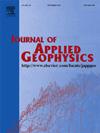Validation of four resistivity mixing models on field time lapse geoelectrical measurements from fine-grained soil undergoing freeze-thaw cycles
IF 2.2
3区 地球科学
Q2 GEOSCIENCES, MULTIDISCIPLINARY
引用次数: 0
Abstract
Resistivity mixing models relate porosity, phase composition and specific resistivities of ground materials to their bulk (effective) electrical properties. These models were typically derived for calculating hydrocarbon saturation from geophysical logs. In permafrost monitoring applications, they have been used to link ground electrical response to its phase composition, with focus on unfrozen water vs. ice content, and to derive changes in ground ice content from repeated resistivity acquisitions. Such quantitative interpretations rely on validity of the mixing models in a context different from the one they were derived in. To increase the reliability of the permafrost forecasts that are based on repeated resistivity surveys, we undertook validation of four selected resistivity mixing model formulations: i) the original Archie's law, ii) the Archie's law with an ice-content dependent cementation exponent (Archie-M), iii) a modification of the Archie's law for multiple conducting phases (Archie-N), and iv) the geometric mean model (GM). The model application context was permafrost monitoring and fate forecasting on natural fine-grained soil undergoing cycles of freezing and thawing, based on indirect (geophysical), in-situ time-lapse resistivity measurements. The purpose of the calibrated resistivity models was to derive the phase composition of the ground from in-situ resistivity measurements, with acceptable quantitative reliability, notably with respect to the amount and changes of ice and water content. In our validation framework, daily temperature-dependent soil phase distribution was converted into an effective resistivity distribution of the ground using each of the four resistivity mixing models. From the effective resistivity model, an apparent resistivity response was forward calculated and compared to time-lapse field apparent resistivity measurements from a permafrost monitoring field site. The performance metrics were i) the root mean square error between the forward-calculated and field-measured apparent resistivities throughout the freeze-thaw season, ii) the percentage of field apparent resistivity data explained by each resistivity model, and iii) the plausibility of the calibrated model parameter estimates. We found that despite different current conducting mechanisms involved in each of the resistivity mixing model formulations, the quantitative performance of the four evaluated models was very similar. The four models typically reproduced the field-measured resistivity variations within one to two standard deviations (STD) of the field measurements, depending on the time of the year and depth in the soil profile. In the active layer, the Archie-M model most consistently reproduced the field data within 1 STD throughout the freezing and frozen periods of the year (September – May). Meanwhile, the GM best matched the actual values of resistivities during freezing. The GM also recovered porosities of the three model layers close to the true values measured on borehole samples. All the tested models were challenged by accurately simulating the thawing period – overestimating resistivities in the temperature range from −5 °C to −2 °C and underestimating them between −2 °C and thawing point. Consequently, the choice between the models should depend on the specifics of a particular application, such as available calibration data, desired parameters or ground properties to resolve, sensitivity of the modeling framework etc. An application-specific validation of several resistivity mixing models and quantification of performance of the chosen resistivity model may be called for. Additionally, the possibility of using different mixing model and water content parameterizations should be investigated, to adequately address complex ground resistivity structures and phase change processes typical of permafrost ground.
在对经历冻融循环的细粒土壤进行的实地延时地质电学测量中验证四种电阻率混合模型
电阻率混合模型将地层材料的孔隙度、相组成和比电阻率与其体积(有效)电特性联系起来。这些模型通常用于计算地球物理测井记录中的碳氢化合物饱和度。在永冻土监测应用中,它们被用来将地层电响应与其相组成联系起来,重点是未冻结的水与冰的含量,并从重复的电阻率采集中推导出地层冰含量的变化。这种定量解释依赖于混合模型在不同于其推导背景下的有效性。为了提高基于重复电阻率测量的永久冻土预报的可靠性,我们对四种选定的电阻率混合模型公式进行了验证:i) 原始阿奇定律;ii) 阿奇定律与冰含量相关的胶结指数 m(阿奇-M);iii) 阿奇定律对多导电相的修正(阿奇-N);以及 iv) 几何平均模型(GM)。模型应用的背景是根据间接(地球物理)、原位延时电阻率测量,对经历冻融循环的天然细粒土壤进行永久冻土监测和命运预测。校准电阻率模型的目的是从原位电阻率测量中得出地层的相组成,其定量可靠性是可以接受的,特别是在冰和含水量的数量和变化方面。在我们的验证框架中,使用四种电阻率混合模型中的每一种,将每日随温度变化的土壤相分布转换为地面的有效电阻率分布。根据有效电阻率模型,正向计算视电阻率响应,并与冻土监测现场的延时现场视电阻率测量结果进行比较。性能指标包括:i) 在整个冻融季节,前向计算的视电阻率与现场测量的视电阻率之间的均方根误差;ii) 每个电阻率模型所解释的现场视电阻率数据的百分比;iii) 校准模型参数估计的可信度。我们发现,尽管每种电阻率混合模型公式中涉及的电流传导机制不同,但四个评估模型的定量性能非常相似。根据不同的时间和土壤剖面深度,这四个模型对实地测量电阻率变化的再现通常在实地测量值的一到两个标准差(STD)范围内。在活动层中,Archie-M 模型在一年中的冻结期和冰冻期(9 月至 5 月)最稳定地再现了实地数据,误差不超过 1 个标准差。同时,GM 与冻结期间的电阻率实际值最为吻合。全球机制还恢复了三个模型层的孔隙率,接近钻孔样本测量的真实值。所有测试模型在准确模拟解冻期方面都遇到了挑战--高估了-5 ℃至-2 ℃温度范围内的电阻率,低估了-2 ℃至解冻点之间的电阻率。因此,对模型的选择应取决于特定应用的具体情况,如可用的校准数据、需要解决的参数或地面特性、建模框架的灵敏度等。可能需要对多个电阻率混合模型进行特定应用验证,并对所选电阻率模型的性能进行量化。此外,还应研究使用不同混合模型和含水量参数的可能性,以充分解决复杂的地面电阻率结构和冻土层典型的相变过程。
本文章由计算机程序翻译,如有差异,请以英文原文为准。
求助全文
约1分钟内获得全文
求助全文
来源期刊

Journal of Applied Geophysics
地学-地球科学综合
CiteScore
3.60
自引率
10.00%
发文量
274
审稿时长
4 months
期刊介绍:
The Journal of Applied Geophysics with its key objective of responding to pertinent and timely needs, places particular emphasis on methodological developments and innovative applications of geophysical techniques for addressing environmental, engineering, and hydrological problems. Related topical research in exploration geophysics and in soil and rock physics is also covered by the Journal of Applied Geophysics.
 求助内容:
求助内容: 应助结果提醒方式:
应助结果提醒方式:


